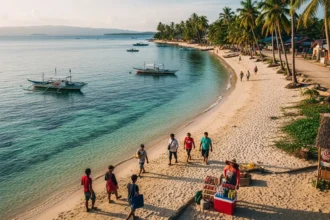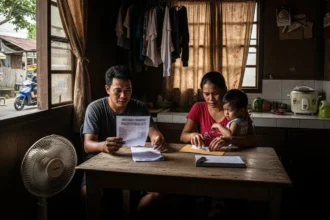Walk through the stone gates of Intramuros, and it feels like time slows down. The noise of modern Manila fades, replaced by cobblestone streets, centuries-old churches, and echoes of the Spanish era. This is the Walled City – ang puso ng kasaysayan ng Maynila – where every wall has a story to tell.
For travelers, Intramuros is more than just a tourist stop. It’s a living museum of Filipino resilience, from the grandeur of the Spanish colonial period to the scars of World War II. And yet, beyond the history books and old photos, Intramuros remains alive today – with locals on kalesa rides, students rushing to class, and families sharing merienda by the plaza.
In this travel guide, we’ll uncover the secrets, top attractions, hidden corners, and practical tips that will help you explore Intramuros like a true insider – whether you’re on a tight budget or chasing cultural depth.
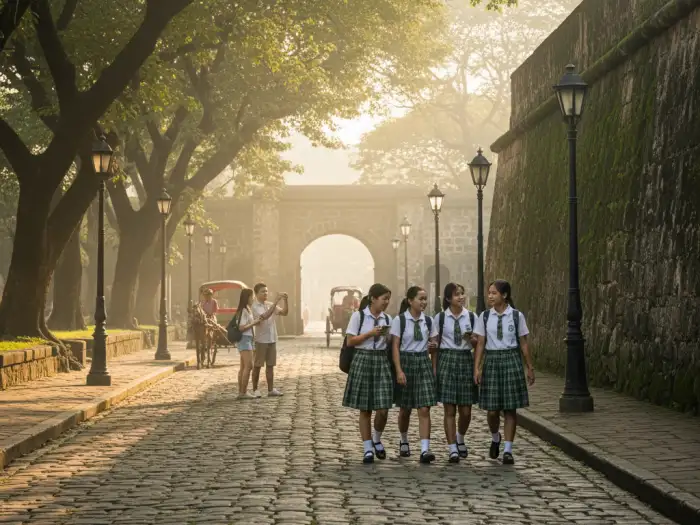
✨ Why Visit Intramuros?
Intramuros isn’t just another tourist attraction – it’s Manila’s living time capsule. Within its centuries-old walls, you’ll find a blend of history, culture, and modern Filipino life that no other destination in the Philippines can quite match.
🏰 A Walk Through History
Built in the late 1500s during the Spanish colonial period, Intramuros was the seat of power for more than 300 years. These walls have witnessed wars, revolutions, and the resilience of Filipinos. Walking here means stepping onto the same cobblestone streets where heroes like José Rizal once stood.
🎭 Culture Meets Everyday Life
What makes Intramuros special is how the past and present exist side by side. Iconic churches like San Agustin and Manila Cathedral stand near buzzing cafés, colorful kalesa rides, and student-filled universities. It’s not just about history – it’s about seeing how culture continues to breathe within the Walled City.
💸 Accessible and Affordable
For travelers, Intramuros is one of the most budget-friendly destinations in Manila. Entrance fees are minimal, several landmarks are free, and you can explore the entire area comfortably in a single day without overspending.
👉 In short, Intramuros is a must-see for travelers who want to experience both heritage and modern Filipino life in one unforgettable walk.
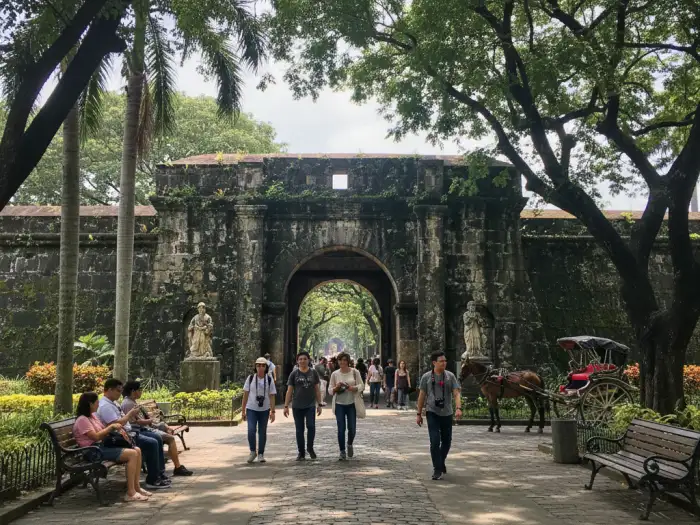
🌟 Top Attractions You Can’t Miss
Intramuros is packed with landmarks that showcase Manila’s colonial past, wartime scars, and cultural resilience. Here are the highlights every traveler should experience:
⛪ San Agustin Church
The oldest stone church in the Philippines (built in 1607), San Agustin Church is a UNESCO World Heritage Site. Inside, its baroque design, trompe l’oeil ceiling paintings, and ornate altars will leave history buffs and architecture lovers in awe. Don’t miss the adjoining San Agustin Museum, which houses centuries-old religious art, manuscripts, and artifacts. Entrance is affordable, and the site is air-conditioned-perfect for a short break from Manila’s heat. Google Map Link: https://maps.app.goo.gl/nfULxJ6RUXtVvvpDA
🏰 Fort Santiago
Perhaps the most famous landmark in Intramuros, Fort Santiago has stood as both fortress and prison. It’s where national hero José Rizal was detained before his execution in 1896, and his final footsteps are preserved in bronze markers leading to his cell. The fort also has World War II memorials, tranquil gardens, and dungeons that once flooded during wartime. A must-see for travelers who want to connect with the Philippines’ struggle for independence. Google Map Link: https://maps.app.goo.gl/bgJtmnccQvY97KUb7
🏠 Casa Manila
If you want to step into the life of the 1800s elite, Casa Manila is your stop. This museum recreates a Spanish colonial house, complete with antique furniture, chandeliers, and courtyards. Walking through its rooms feels like being transported into the past. It’s a favorite among students, families, and even prenup photographers looking for that old-world vibe. Google Map Link: https://maps.app.goo.gl/MuFh2mj7peVujhpF9
✝️ Manila Cathedral
Known as the “Mother of All Churches” in the Philippines, the Manila Cathedral has been rebuilt multiple times after earthquakes and wars. Its current form is grand and resilient, featuring stained glass windows and an enormous pipe organ. The cathedral is an active place of worship, so expect to see weddings and ceremonies during your visit. It’s free to enter, making it an accessible stop for all travelers. Google Map Link: https://maps.app.goo.gl/eeZuxPz7TFijB9dB8
🧱 Baluarte de San Diego
Hidden inside Intramuros’ walls is the circular fortification of Baluarte de San Diego, one of the oldest stone structures in Manila. Surrounded by manicured gardens, this site is great for leisurely walks, photo sessions, and panoramic views of the city walls. Its unique design shows the blending of European and Asian architectural influences. Google Map Link: https://maps.app.goo.gl/5xFshFb56gAKmFox6
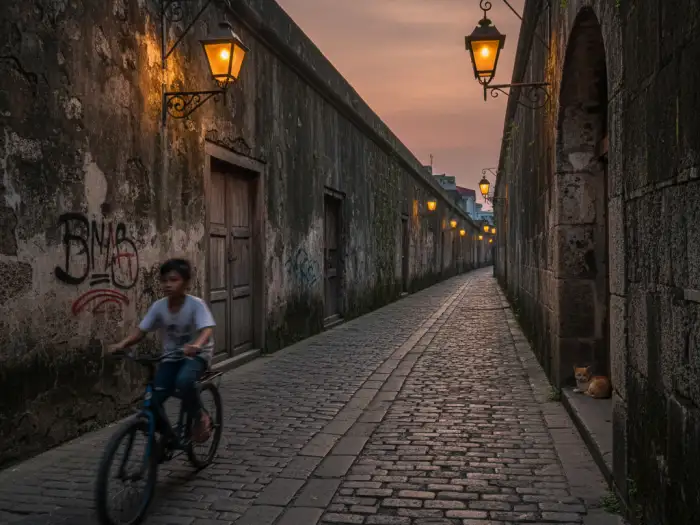
🔑 Hidden Secrets and Stories of Intramuros
Beyond the well-known landmarks, Intramuros holds whispers of forgotten tales, mysterious ruins, and cultural fragments that make exploring the Walled City unforgettable. Here are some hidden gems and little-known stories that every curious traveler should know:
🕯️ Wartime Ruins That Still Stand
Scattered around Intramuros are remnants of World War II bombings. Crumbling walls, bullet-scarred stones, and ruins left deliberately untouched serve as silent memorials. These corners are often overlooked by day-trippers, but pausing here gives perspective on the devastation Manila endured during the war.
👻 Ghost Stories After Dark
Intramuros is famous for its haunted reputation. Old dungeons, narrow alleys, and historic churches all have stories of restless spirits. While some of these tales are folklore, they add a layer of intrigue to evening tours. For brave travelers, guided “Intramuros at Night” or ghost walks reveal both history and mystery.
⛪ Forgotten Chapels and Courtyards
Not all of Intramuros’ treasures are grand. Hidden between universities and offices are small chapels and courtyards, some in quiet decay, others lovingly maintained by locals. These peaceful spots are perfect for short breaks away from the busy streets and a reminder of the city’s once-dense religious life.
🕳️ Underground Tunnels and Secrets
Few travelers know that parts of Intramuros are connected by underground tunnels used during wartime. Some sections remain inaccessible, but stories of hidden passageways continue to fascinate historians and tour guides alike. Ask local guides about these tunnels – they often share insider stories that aren’t written in textbooks.
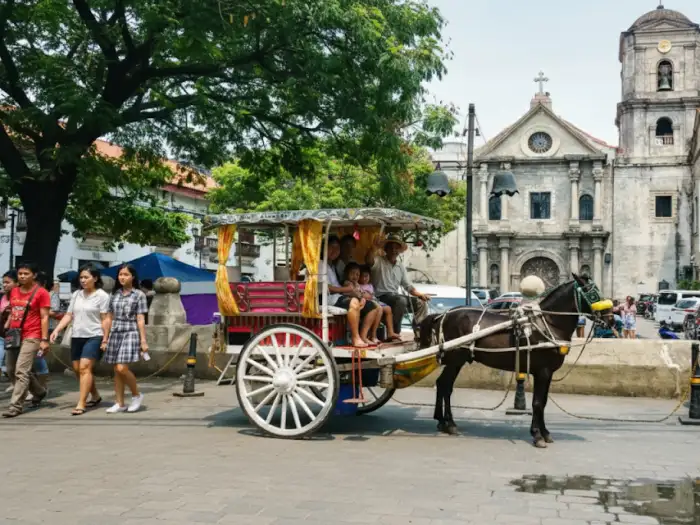
🚲 Experiencing Intramuros Like a Local
The real charm of Intramuros isn’t only in its centuries-old landmarks – it’s in how you experience it. Travelers who walk, ride, and eat like locals often leave with the richest memories. Here’s how to enjoy the Walled City the way Manileños do:
🐴 Taking a Kalesa Ride
One of the most memorable experiences in Intramuros is the kalesa, the traditional horse-drawn carriage. These rides aren’t free – rates usually start at ₱500–₱1,000 for a 30–45 minute tour, depending on the route and number of passengers. You can usually find kalesas waiting near Fort Santiago, San Agustin Church, and Manila Cathedral.
💡 Traveler Tips:
- Always negotiate the price before starting your ride to avoid surprise charges.
- Ask if the fee is per person or per ride – some drivers differ.
- Be mindful of the horses: choose a healthy-looking horse and avoid overloading the carriage.
- A kalesa ride is best enjoyed as a short cultural treat rather than your main mode of transport.
🚴 Exploring on Two Wheels
If you’d rather move at your own pace, consider joining a Bambike Ecotour – guided tours using handmade bamboo bicycles. Prices range from ₱600–₱1,200 per person, depending on the length of the tour. The guides are excellent storytellers who mix history with humor, making it ideal for first-time visitors.
If you don’t want a guided tour, you can also rent regular bicycles inside Intramuros or bring your own. Biking allows you to cover more ground than walking while still taking in the sights up close.
💡 Traveler Tips:
- Book Bambike tours online in advance, especially on weekends.
- Wear comfortable shoes and sun protection – biking under Manila sun can be intense.
- Stick to designated biking areas and be careful with traffic near the gates.
🍲 Eating Like a Local
Skip the tourist-priced cafés for at least one meal and try local flavors:
- Carinderias (local eateries) serve home-style dishes like adobo, pancit, or sinigang for less than ₱100.
- Street food stalls offer kwek-kwek, fish balls, and banana cue for a quick, cheap snack.
- For a cultural twist, drop by Barbara’s Heritage Restaurant, which offers both Filipino dishes and cultural shows (though at higher prices).
💡 Traveler Tips:
- Bring small bills and coins for easier payments.
- Follow the locals: if a stall is busy, it’s usually safe and tasty.
- Don’t forget to hydrate – bring your own water bottle or buy from sari-sari stores inside.
🌅 Best Times to Visit
- Morning (7–10 AM): Cooler weather, fewer crowds, great for walking tours.
- Late Afternoon (4–6 PM): Golden light for photography and a more relaxed vibe.
- Evening: Romantic atmosphere, perfect for night tours or ghost walks – but always go with a group for safety.
💡 Traveler Tips:
- Avoid midday if possible – the Manila sun plus the stone walls can feel like an oven.
- Bring an umbrella that works for both sun and sudden rain showers.
🎒 Blending In and Staying Comfortable
- Wear light clothing but dress modestly if you plan to enter churches.
- Comfortable walking shoes are a must; cobblestone streets can be rough on sandals.
- Keep your belongings close – Intramuros is generally safe, but like any city, pickpockets can be around.
- Take breaks at plazas, benches, or shaded areas. Part of the Intramuros experience is just sitting and watching life unfold.
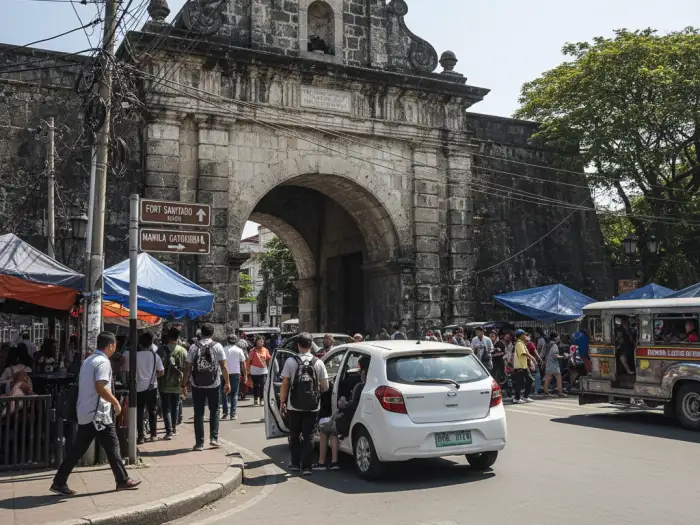
💡 Practical Travel Tips
Planning ahead will make your Intramuros visit smoother and more enjoyable. Here’s what every traveler should know before exploring Manila’s Walled City:
🚕 Getting There
- By Grab/Taxi: The easiest way for first-timers. From Manila airport, expect ₱250–₱350 depending on traffic.
- By Jeepney: Routes from Lawton, Divisoria, and Ermita pass through or near Intramuros. Fares are around ₱15–₱20.
- By LRT: Get off at Central Terminal Station; from there it’s a short walk or tricycle ride.
- On Foot: If you’re coming from Rizal Park (Luneta) or Manila City Hall, Intramuros is just across the street.
💡 Tip: Manila traffic can be unpredictable. If you’re on a tight schedule, plan to arrive in the morning.
📅 Best Time to Visit
- Dry Season (Dec–May): Most reliable weather.
- Weekdays: Less crowded than weekends.
- Golden Hour (4–6 PM): Best for photography and cooler walks.
💡 Tip: Avoid midday heat; cobblestones and stone walls amplify the sun, making it uncomfortable to walk.
🛡️ Safety and Comfort
- Intramuros is generally safe, but like any urban area, keep an eye on your bag.
- Avoid wandering into dark alleys at night unless you’re on an organized tour.
- Wear comfortable shoes – cobblestones can be slippery in the rain.
- Carry a small umbrella for both sudden downpours and shade.
💡 Tip: Bring bottled water or a refillable tumbler – hydration is key in Manila’s heat.
💸 Budget Tips
- Entrance Fees: Fort Santiago (₱75 students, ₱100 adults), San Agustin Museum (₱200), Casa Manila (₱75–₱100). Many churches and plazas are free.
- Tours: Kalesa rides ₱500–₱1,000 (negotiate first), Bambike tours ₱600–₱1,200.
- Food: Street snacks start at ₱20, carinderia meals ₱60–₱100, sit-down restaurants ₱250+.
💡 Tip: Combine free attractions (plazas, churches, walls) with 1–2 paid sites for a well-rounded but affordable trip.
📸 Photography and Etiquette
- Drones are restricted in most areas; check rules before flying.
- Be respectful when taking photos inside churches, especially during mass or weddings.
- Early morning and late afternoon provide the best natural lighting.
💡 Tip: For less crowded shots, visit on weekdays before 9 AM.
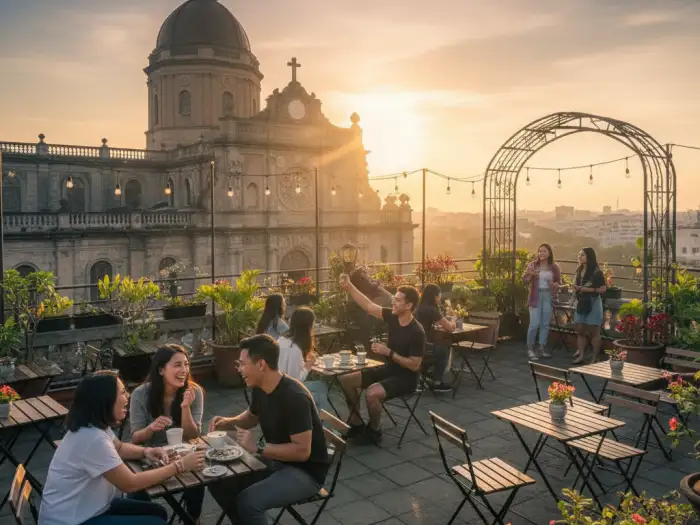
🍴 Where to Eat and Relax Nearby
After hours of walking Intramuros’ cobblestone streets, you’ll need a good meal or a quick break. Luckily, the Walled City and its surroundings offer plenty of options for every budget.
🥘 Heritage Dining
- Barbara’s Heritage Restaurant: A favorite for visitors wanting both food and culture. Serves Filipino-Spanish dishes like paella, adobo, and kare-kare. In the evenings, they host cultural shows with traditional music and dances. Expect ₱500–₱800 per person.
- Ilustrado Restaurant: Known for its elegant atmosphere and classic Filipino dishes. Their paella and callos are popular, and they also serve international options. Prices are higher (₱500+ per meal), but it’s a solid choice for special occasions.
🍲 Budget-Friendly Eats
- Carinderias and Food Stalls: Scattered around General Luna Street and near universities inside Intramuros. Perfect for quick meals under ₱100. Dishes include silog meals, pancit, and tapsilog.
- Street Snacks: Look out for fish balls, kwek-kwek, and banana cue vendors near plazas and church gates. Tasty, filling, and very affordable.
☕ Cafés and Chill Spots
- La Cathedral Café: A rooftop café behind Manila Cathedral, offering coffee and light meals with a stunning view of the church’s façade. Prices are mid-range (₱150–₱300). Best visited late afternoon or evening.
- Papakape at Intramuros: A small café known for strong brews and affordable sandwiches, popular with students.
🌳 Where to Rest and Recharge
- Public plazas like Plaza San Luis or Plaza Roma are shaded by trees and surrounded by historic buildings. Great for a break if you’ve packed snacks or drinks.
- Benches along the walls provide quiet spots for watching the sunset or just people-watching.
💡 Traveler Tip: Restaurants inside Intramuros close earlier than those in modern malls – plan your meals before 9 PM. For late-night dining, you’ll need to head out to nearby Ermita or Malate.
❓ Frequently Asked Questions about Intramuros Travel
- Is Intramuros worth visiting?
Yes! Intramuros is Manila’s historic Walled City, offering a mix of Spanish-era architecture, museums, churches, and cultural experiences. It’s a must-see for both locals and tourists who want to connect with Philippine history. - How much is the entrance fee to Intramuros?
Most of Intramuros is free to explore, including streets, plazas, and churches like the Manila Cathedral. Paid attractions include Fort Santiago (₱75–₱100), San Agustin Museum (₱200), and Casa Manila (₱75–₱100). - How do I get to Intramuros?
You can reach Intramuros by Grab or taxi from anywhere in Metro Manila. It’s also accessible by jeepney or LRT (Central Terminal Station). From Rizal Park or Manila City Hall, it’s just a short walk. - What is the best time to visit Intramuros?
The best times are early morning (7–10 AM) or late afternoon (4–6 PM) when it’s cooler and less crowded. Evening visits are also great for night tours, but go with a group for safety. - Are kalesa rides in Intramuros free?
No, kalesa rides cost around ₱500–₱1,000 depending on distance and negotiation. They can be found near Fort Santiago, San Agustin Church, and Manila Cathedral. Always agree on the price before starting the ride. - Can I join guided tours in Intramuros?
Yes, there are several options: Bambike Eco Tours (₱600–₱1,200), walking tours led by local historians, and themed tours like ghost walks at night. Guided tours are the best way to uncover hidden stories. - What should I wear when visiting Intramuros?
Light, breathable clothes and comfortable walking shoes are recommended. If you plan to enter churches, modest attire (covered shoulders and knees) is expected. Bring an umbrella for sun or sudden rain. - Is Intramuros safe for tourists?
Yes, Intramuros is generally safe, especially during the day. Like any city, watch your belongings and avoid dark alleys at night unless you’re with a tour group. - Where can I eat inside Intramuros?
You’ll find a mix of options: heritage restaurants like Barbara’s and Ilustrado, affordable carinderias serving silog meals, street food vendors, and cafés like La Cathedral Café with rooftop views. - How long should I spend in Intramuros?
A half-day is enough to see the highlights, but a full day lets you explore more deeply-covering top attractions, hidden corners, food spots, and even a night tour.
🌏 Walking Through History, Living the Present
Intramuros isn’t just a place you visit – it’s a place you feel. Every cobblestone, every weathered wall, every quiet courtyard carries stories of battles, faith, and survival. Yet it’s not frozen in time. Today, it’s alive with students rushing to class, families enjoying merienda, and travelers discovering hidden corners.
For anyone exploring Manila, Intramuros offers a rare gift: the chance to step back into centuries of history while still experiencing the vibrance of modern Filipino life. It proves that heritage doesn’t belong only in textbooks or museums – it’s woven into the streets we walk every day.
So whether you’re here for a quick half-day visit or a deep dive into Manila’s soul, let Intramuros remind you of this: the past isn’t gone – it’s part of the present, and it’s waiting for you to explore.
🧭 References
-
Guide to the Philippines – Ultimate Travel Guide to Intramuros Old Town
-
Free Two Roam – Exploring The Old Walled City of Manila: Intramuros
-
Mad Monkey Hostels – Exploring Intramuros: Manila’s Walled City Adventure
-
Intramuros Administration (Facebook) – Official Intramuros Administration
-
GetYourGuide – The BEST Intramuros Guided Tours 2025
-
Property Report PH – Underrated Spots to Visit in Intramuros
-
Paseos de Intramuros – Guidebook to Manila’s Walled City




